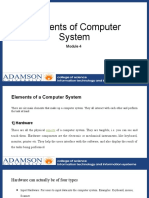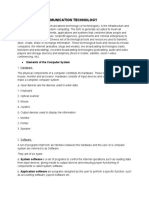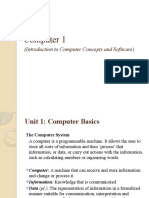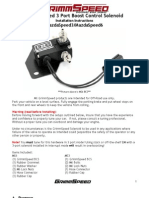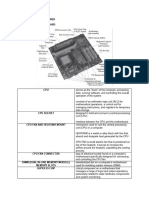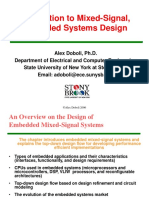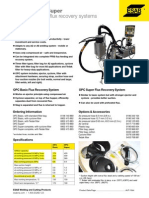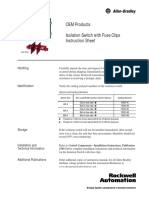This Self-Learning Module will help you get acquainted with the
Computer Systems through its essential elements. After going through the
readings, answering the activities, and performing assigned task, you are
expected to:
Understand Computer System through its essential elements and various
activities.
Interpret the Block Diagram of Computer System and its component
through an Illustration
Understanding Computer System
We are all aware of what computers are and their immense importance in
our daily lives. It is an electronic device that not only stores data but also
processes and manipulates data to carry out functions. Upon receiving valid
instructions, a computer can perform a variety of operations.
What allows us to perform such tasks on the computer is a computer
system. A computer system is the sum of all the components (hardware and
software) that makes up a fully functional computer.
It is a set of integrated devices and peripherals which inputs data, process it
and give output. It can also store electronic data and information.
Elements of the
The main elements that make up a computer system interact with
each other and perform the task at hand are the following:
Hardware
Software
Liveware
Procedures
Data
Connectivity
Hardware
These are all the physical aspects of a computer system. They are
tangible, i.e. you can see and touch them.
Hardware can be of four types, depending on which function they
perform. The four types of hardware are:
Input Hardware: Used input data into the computer system such as
keyboard, mouse, scanner, and microphone.
Processing and Memory Hardware: These are where the data and
information are processed and manipulated. It consists of the Central
Processing Unit (CPU)and the primary memory which is known as the
Random-Access Memory (RAM).The CPU is responsible for controlling
all the activities of the computer, as well as the input/output, memory
2
� and other devices connected to The primary memory (RAM) stores
input data temporarily for immediate calculation results but cannot
store vast amount of data.
Secondary Storage Hardware: Also known as the Secondary Memory,
it is where the computer system stores data permanently for future
use such as the Hard disk(HDD),Solid State Drives(SSD),Flash Drives
and CD/DVD.
Output Hardware: It consists of devices that are used to display the
results or output of the process such as the Monitor, Printer and
Projector.
The image above shows the Block Diagram of the Computer System, where data
enters(input) the computer, later being processed (CPU) or stored (Memory Unit), allowing
user to have an output (in the form of audio, visual or printed).
Software
Software is nothing but a set of programs (computer instructions), which
helps the user to do a set of specific tasks. It helps the user interact with the
computer system with the help of hardware. Software, as you can imagine, is the
intangible aspect of the computer system.
Basically, there are six main types of software, which are as follows,
Operating System: These specialized programs that allow the
communication between software and hardware. The OS runs all the
other computer programs, and even regulate the startup process of the
computer. Examples of OS are Windows OS (Windows 7, Windows 10
Windows Server and Windows 11), Mac OS (OS X El Capitan and macOS
Mojave) and Linux OS(Debian, Ubuntu, Gentoo)
Application Software: These are designed to perform a specific task
or a bunch of tasks. They can be user-designed (specific to the user’s
needs) or
readymadeapplicationsoftware.ExampleofthisareMicrosoftSuite,Skype
Utility Software: It helps maintain and protect the computer system.
Examples are Anti-virus, Disk Clean-up tools, Back-up Utility
Language Processors: Software that interprets computer language
and translates it into machine language. It also checks for errors in
3
� language syntax and fixes the problems.
System Software: These types of software control the hardware, the
reading of the data and other such internal functions. Examples are
Device Drivers, Firmware’s
Connectivity Software: The special software that facilitates the
connection between the computer system and the server. This allows
the computer to share information and communicate with each other.
Examples are Windows Remote Desktop, and TeamViewer
Liveware
The people interacting with the computer system are called Liveware.
They are the ultimate “users” of the computer systems. There are three types
of people that interact with the system, namely:
o Programmers: Professionals who write the computer programs that
allow users to interact with the computer. They must have technical
knowledge of computers and computer languages.
o System Analyst: They mainly design data processing systems, and
solve problems that arise in data processing
o End-Users: Also known as operators, they are the people who
interact with the computer system.
Procedures
These are a set of instructions, written in code, to instruct a computer on
how to perform a task, run a software, do calculations etc. There are three
types of procedures in a computer
They are:
o Hardware-Oriented Procedure: Instructs the hardware components
of the system, ensures the work smoothly
o Software Oriented Procedure: Provides instructions to launch and run
software programs
o Internal Procedures: Directs the flow of information and sequences the
data
Data
Data is essentially the raw facts and figures that we input in the computer.
The data
gets processed via the computer system and becomes information, which is
processed and organized data. Information can then be used for decision-
making purposes.
The measurement of data is done in terms of “bytes”. One kilobyte (KB) is
approximately 1000 bytes,1megabyte(MB) is 1million bytes and
finally,1gigabyte(GB) is approximately 1 billion bytes.
Connectivity
This is when the computers are linked to a network. It facilitates sharing of
information, files, and other facilities. Computers can connect to a network via LAN
cables, Bluetooth, Wi-Fi, satellites etc. The internet is the most obvious example of
connectivity in computer system.
References:
4
� https://quicklearncomputer.com/block-diagram-of-computer-system/
https://www.toppr.com/guides/accountancy/application-of-
computers-in-accounting/meaning-and-elements-of-computer-
system/
https://kencorner.com/understanding-computer-system/
https://www.toppr.com/guides/accountancy/application-of-
computers-in-accounting/meaning-and-elements-of-computer-
system/
https://www.macworld.co.uk/feature/os-x-macos-versions-3662757/










